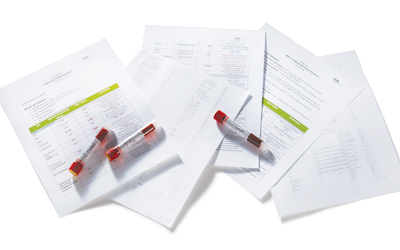Using just a droplet of blood, a new test can unlock the history of every virus you’ve ever been exposed to.
The VirScan test was announced in June 2015 in the journal Science. At present, the test is still experimental, but it could be used to develop new vaccines, become an essential research tool for tracking disease outbreaks around the globe — and may have future applications that are yet to be discovered.
The test was developed by researchers led by biologist Stephen J. Elledge, PhD, professor of genetics at Harvard Medical School and Boston’s Brigham and Women’s Hospital.
“I’m sure there’ll be lots of applications we haven’t even dreamed of,” Elledge told the New York Times. “That’s what happens when you invent technology — you can’t imagine what people will do with it.”
The test detects antibodies present in your blood — proteins your immune system produces to attack an invading virus. Finding these antibodies then provides the history of viruses you have been infected with throughout your life.
“Antibodies are produced long after we clear the infection and continue to circulate in our blood,” explains Benjamin Larman, PhD, assistant professor of pathology at Johns Hopkins and VirScan co-developer. “These antiviral antibodies can be thought of like grooves in a record, and VirScan is like a record player that plays back the music corresponding to those grooves.”
To create the test, the researchers assembled a library of almost 100,000 proteins, each of them representing a portion of a virus that an antibody might recognize. When an individual protein is added to a drop of blood, antibodies attach to matching fragments, allowing the scientists to determine which viruses someone has been infected with and what antibodies their body generated in response.
Currently, VirScan can detect past exposure to more than 1,000 virus strains from 206 species, which covers most of the human virome —the viruses known to infect people. The test also could “easily be expanded to include new viruses as they are discovered, as well as other human pathogens, such as bacteria, fungi, and protozoa,” the researchers write in their paper.
In developing the test, Elledge and fellow researchers sought a way to test for multiple viruses at the same time. There is no current test that can trace all of the antibodies in a patient’s blood; in fact, doctors needing to determine whether a patient has a particular viral infection sometimes need to test blood samples for a single pathogen at a time.
“Current serological methods to detect viral infections are predominantly limited to testing one pathogen at a time and are therefore used primarily to address specific clinical hypotheses,” the research write. “A method that could simultaneously detect responses to all human viruses would allow hypothesis-free analysis to detect associations between past viral infections and particular diseases or population structures.”
The researchers tested VirScan with 596 people on four continents — in the United States, Peru, South Africa, and Thailand. They found that most people had been exposed to on average 10 species of viruses, including those causing colds (rhinoviruses), flu, and gastrointestinal issues, as well as common viruses such as the herpes virus. (They also found two people who had exposure to an incredible 84 virus species.)
Immunologists currently believe that people’s immune response may differ by geography and even individually. But the initial VirScan results found that many people around the world generated the exact same antibodies to infections.
This suggests “that antibodies with highly similar specificities, and possibly structures, are elicited across individuals,” the researchers write. This finding could inform future vaccine development, Elledge says.
And finally, if you’re squeamish about giving blood, VirScan requires a pinprick draw of only 1 micoliter — a millionth of a liter — far less than other tests.
Q&A With Benjamin Larman, PhD
VirScan Co-Developer and Paper Coauthor, Assistant Professor in the Pathology Department at Johns Hopkins
Experience Life | What applications do you foresee for the test?
Benjamin Larman | There is a wide variety of both research and clinical applications for VirScan. In our paper, we presented a basic epidemiological research study. We envision that future studies will seek to address more specific questions, such as defining new correlations between particular viral infections and the variety of conditions that affect human health. Many autoimmune diseases, for example, are believed to be triggered by viral infection. VirScan is primarily a research technology, but we are working to develop derivative tests that are more appropriate for clinical settings. As more is learned about viral infections and how to treat them, we believe this type of test will become an important part of medical practice.
EL | How did you go about creating the test and why?
BL | In earlier work, we used a similar methodology to create a synthetic version of all human proteins. We used this to study the anti-self antibodies associated with autoimmune diseases. VirScan uses a synthetic version of all human viral proteins to detect antibody responses to viruses. Because of the way that the technology works, we’re able to test a large number of blood samples at relatively low cost, and with minimal blood from the donor. Viral infection plays an important role in human health (particularly when you have a toddler in daycare!), and so we anticipated that people would find all sorts of ways to use VirScan, once we could show how well it worked.
EL | How do the viruses show up in our blood?
BL | VirScan measures antibodies against viruses, not the viruses themselves. So even viruses that infect the lung or GI tract, for example, elicit antibodies when we fight off the infection.
EL | Can the test tell you when you had the virus, or just that you had it?
BL | This is an important goal for future technical developments of VirScan. We have some preliminary data suggesting that we can use VirScan to analyze a specific type of antibody, which is produced early in infection, to tell us whether the infection is recent or not. We’re also working to determine whether there are specific temporal patterns of responses (to different viral proteins) that can be used to chart out a person’s response over time. If so, then these patterns can be used to back-calculate the duration of infection (sort of like carbon dating of archeological artifacts).




This Post Has 0 Comments